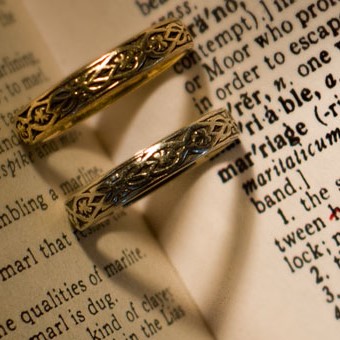CURRENT AFFAIRS
Does the LGBT Community Really Want Marriage?
By Michael Gentry

Gay activist groups have also been fueling the fire as well. One in particular, Movement Advancement Project (MAP) has literally made it their life's mission to "...help speed equality for lesbian, gay, bisexual and transgender (LGBT) people."
The Growing Moves Among States
According to public record, same-sex marriage has been legal in Massachusetts since May 17, 2004; in Connecticut since November 12, 2008; in Iowa since April 27, 2009; in Vermont since September 1, 2009; New Hampshire since January 1, 2010; in Washington, D.C. (though not a state) since March 9, 2010; and in New York since July 24, 2011. And, although Maryland and Rhode Island have not legalized such unions, they recognize gay marriages performed out-of-state.
In 2010, the Human Rights Campaign reported that 29 states have constitutional amendments restricting marriage to one man and one woman, while 12 others have laws "restricting marriage to one man and one woman." On Tuesday, May 8, 2012, one day before President Obama announced his support for same-sex marriage, North Carolina voters overwhelmingly opposed the idea by voting in favor of Amendment One, which makes it the 30th state in the union with a constitutional provision restricting marriage to the union of one man and one woman.
What the Numbers by State Reveal
In examining the data, it's hard not to agree with Frank Rich, who wrote in his February 26th New York Magazine article entitled, Whitewashing Gay History, "Fran Lebowitz is correct to remind us that not all gay people (any more than all straight people) are beating down the doors to what she calls 'the two most confining institutions on the planet, marriage and the military.'" However, for purposes of this article, the numbers will be confined to the marriage debate.
Below are links that summarizes data thru 2010 in the states — plus DC — where same-sex marriage (SSM) is currently legal. For a more detailed analysis, source links are provided in the footnotes that follow this link. The data shows three significant observations:
1. An interesting coincidence to note is that, across the board, Same-Sex Couples (SSCs) represent only seven percent of the total LGBT (Lesbian, Gay, Bi-sexual, Transgender) population within these states. This significantly low percentage can probably be explained by a few reasons. Perhaps this segment of our society is less inclined to enter into a "LTR" (long term committed relationship) relative to heterosexual couples. Comparatively speaking to the nation as a whole, according to the 2010 US Census, there are 56 million heterosexual married couples and another 8 million who simply live together. This is a total of 64 million committed opposite-sex relationships. That comes to 21% of the total US population of 300 million people, or in other words three times greater than SSCs, where such marriages are legal. Maybe, like heterosexuals, it means most of them are either having a hard time finding the 'right mate'; or they simply do not wish to marry at all; or a combination of the two.
2. Despite the low number of SSCs relative to the entire LGBT population within these states, on average 19% of all LGBT people in them are raising children. That means the vast majority of them are raising kids out-of-wedlock.
For a group of people who want to enjoy the rights, lights and benefits of the "sanctity of marriage" what message does this send to society in general who they want to support marriage equality? And moreover, what example does this set for their children?
3. Finally, in states where marriage has been deemed legal for SSCs, on average only 31% have had a desire to be married from 2004 thru 2010.
Granted, there may be more shown as later US Census results become available. However, the fact is, nearly 70% of SSCs in states where their marriages would be legally recognized have opted not to marry. Perhaps Fran Lebowitz (an openly gay female celebrity) is correct, when she said there was a time when the gay freedom movement meant just that; freedom from the confines of marriage.
Nevertheless, it begs the question posed by the title of this article, do LGBT really want marriage? If marriage equality is so vital to what President Obama called their right as "full citizens," then why aren't LGBT in the states that have pioneered this initiative blazing the trail for others states by marrying in droves? A more poignant question is, if not, then why all the "hype" and sense of urgency by its proponents?
Is it because the issue really isn't about marriage equality at all, but rather about a more subtle hidden agenda; of legitimizing a "lifestyle" that 30 out of 50 other states believe should be solely defined as a union between one man and one woman?
KEY TABLE
[1] States are listed chronologically based on when same-sex marriage became legal in that state.
[2] Total LGBT (Lesbian, Gay, Bi-sexual, Transgender) population by state based on data from MAP (Movement Advancement Project).
[3] Total number of LGBT population by state that are raising children based on data from MAP.
[4] Percentage of total LGBT population by state that are raising children based on data from MAP.
[5] Total number of Same-Sex Couples (SSCs) by state per the 2010 US Census preferred estimates.
[6] Percentage of SSCs per the total LGBT population by state based on data from MAP.
[7] Total number of unmarried SSCs by state per the 2010 US Census preferred estimate detailed tables.
[8] Total number of SSCs by state that are married per the 2010 US Census preferred estimate detailed tables.
[9] Percentage of SSCs by state that are married per the 2010 US Census preferred estimates.
Image Credit: Troy B. Thompson; "Equal Hearts"; Creative Commons
comments powered by Disqus
Published on 5-30-12

